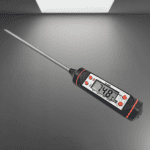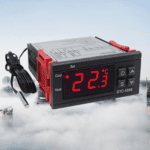There are various types of temperature sensors including RTDs, thermocouples, thermistors, infrared sensors, and semiconductor-based sensors. Gain insights into how these sensors accurately measure temperature and find applications in different industries.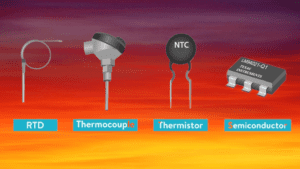
Temperature sensor working principle
Temperature sensors work based on the principle of utilizing the physical properties of materials that change with temperature. The most common working principles include:
- Resistance-based sensors: These sensors, such as Resistance Temperature Detectors (RTDs) and thermistors, rely on the variation of electrical resistance with temperature. As the temperature changes, the resistance of the sensing element either increases or decreases, and this change is measured to determine the temperature.
- Voltage-based sensors: Thermocouples and semiconductor-based sensors operate on the principle of generating a voltage signal proportional to the temperature difference between two junctions or the temperature-dependent properties of semiconductor materials. The voltage output is then correlated to the corresponding temperature using calibration curves or conversion equations.

- Optical sensors: Infrared (IR) temperature sensors detect and measure the thermal radiation emitted by objects. They use the relationship between an object’s temperature and the intensity of infrared radiation it emits. By capturing and analyzing this radiation, the sensor determines the temperature of the object.
- Fluid-based sensors: Some temperature sensors use the expansion or contraction of fluids, such as mercury or alcohol, with changes in temperature. The expansion/contraction is converted into a mechanical displacement, which can be measured and correlated to the temperature.
These are the general working principles of temperature sensors. Different types of temperature sensors utilize specific techniques to measure temperature accurately and reliably in various applications.
Types of Temperature Sensor
There are several types of temperature sensors commonly used in various applications. Here are some of the most widely used types:
- Resistance Temperature Detectors (RTDs): RTDs are made of pure metals, typically platinum (Pt), and their resistance changes with temperature. They provide accurate and stable measurements over a wide temperature range. Platinum RTDs are commonly used in industrial and laboratory settings.

- Thermocouples: Thermocouples consist of two dissimilar metal wires joined together at one end, forming a junction. The temperature difference between the junction and the other end of the wires generates a voltage proportional to the temperature. Thermocouples are rugged, versatile, and can measure high temperatures. They are commonly used in industrial applications.
- Thermistors: Thermistors are temperature-sensitive resistors made of ceramic or semiconductor
 materials. They exhibit a significant change in resistance with temperature. There are two types: Negative Temperature Coefficient (NTC) thermistors, where resistance decreases with temperature, and Positive Temperature Coefficient (PTC) thermistors, where resistance increases with temperature. Thermistors are commonly used in consumer electronics, automotive applications, and temperature control systems.
materials. They exhibit a significant change in resistance with temperature. There are two types: Negative Temperature Coefficient (NTC) thermistors, where resistance decreases with temperature, and Positive Temperature Coefficient (PTC) thermistors, where resistance increases with temperature. Thermistors are commonly used in consumer electronics, automotive applications, and temperature control systems. - Infrared (IR) Sensors: Infrared temperature sensors detect and measure the thermal radiation emitted by objects. They use infrared technology to measure the temperature without physical contact. IR sensors are non-invasive, fast, and suitable for measuring the temperature of moving objects or in environments where direct contact is not possible or desirable.
- Semiconductor-based sensors: These sensors use semiconductor materials, such as diodes or
 integrated circuits (ICs), to measure temperature. They utilize the temperature-dependent characteristics of semiconductors, such as voltage or current, to determine the temperature. Semiconductor sensors are compact, low-cost, and commonly used in various applications, including consumer electronics and automotive systems.
integrated circuits (ICs), to measure temperature. They utilize the temperature-dependent characteristics of semiconductors, such as voltage or current, to determine the temperature. Semiconductor sensors are compact, low-cost, and commonly used in various applications, including consumer electronics and automotive systems. - Bimetallic Strips: Bimetallic temperature sensors consist of two different metal strips bonded together, which have different coefficients of thermal expansion. With temperature changes, the strips bend or deform, and this mechanical displacement is converted into temperature measurements.
These are some of the main types of temperature sensors used in different industries and applications. The appropriate sensor selection depends on factors such as temperature range, accuracy requirements, response time, and environmental conditions.
Temperature sensors working range & material of construction
| Temperature Sensor | Working Range | Construction Materials |
| Resistance Temperature Detectors (RTDs) | -200°C to +850°C | Platinum (Pt) |
| Thermocouples | -270°C to +2300°C | Various combinations of metals |
| Thermistors | -90°C to +300°C | Ceramic or semiconductor materials |
| Infrared Sensors | -50°C to +3000°C | Various housing materials |
| Semiconductor Sensors | -50°C to +150°C | Silicon, gallium nitride (GaN), and other semiconductor materials |
| Bimetallic Strips | -50°C to +300°C | Two different metal strips bonded together |
These ranges and materials are approximate and can vary depending on specific sensor models and manufacturers. It’s always recommended to refer to the specifications provided by the sensor manufacturer for precise information.
Applications of Temperature sensors
Temperature sensors find applications in various industries and fields. Here are some common applications of temperature sensors:
- HVAC Systems: Temperature sensors are essential in heating, ventilation, and air conditioning (HVAC) systems to monitor and control the temperature of indoor environments for optimal comfort and energy efficiency.

- Industrial Processes: Temperature sensors are used in industrial processes to ensure precise temperature control for manufacturing, chemical reactions, refining, and other industrial applications.
- Food and Beverage Industry: Temperature sensors are employed in food processing, storage, and transportation to monitor and maintain safe temperatures, ensuring food quality and safety.
- Automotive: Temperature sensors are utilized in automotive engines, exhaust systems, and cooling systems to monitor and regulate temperature for optimal performance, emissions control, and safety.
- Medical and Healthcare: Temperature sensors play a critical role in medical equipment and healthcare applications, including patient monitoring, temperature-controlled storage of medications and vaccines, and temperature-sensitive medical procedures.
- Environmental Monitoring: Temperature sensors are used in environmental monitoring systems to track temperature variations in habitats, weather stations, climate research, and greenhouse monitoring.
- Energy Management: Temperature sensors assist in energy management systems by monitoring and controlling temperature in buildings, optimizing energy usage, and enhancing energy efficiency.
- Aerospace and Aviation: Temperature sensors are vital in aerospace applications to monitor the temperature in aircraft engines, fuel systems, and critical components, ensuring safe and efficient operation.

- Research and Laboratories: Temperature sensors are extensively used in scientific research and laboratories to measure and control temperature accurately for experiments, sample analysis, and calibration purposes.
- Consumer Electronics: Temperature sensors are integrated into various consumer electronic devices, such as smartphones, laptops, and home appliances, to prevent overheating, regulate battery charging, and ensure device safety.
what is temperature sensor
A temperature sensor is a device or component designed to measure and detect temperature. It converts temperature changes into an electrical signal or output that can be measured, recorded, or used for control purposes. Temperature sensors are used to monitor and regulate temperature in various applications, ranging from industrial processes and HVAC systems to consumer electronics and medical devices.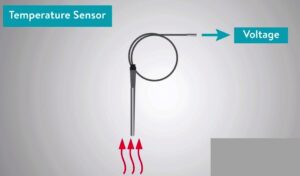
Temperature sensors can utilize different principles to measure temperatures, such as changes in electrical resistance, voltage, or optical properties. Some common types of temperature sensors include Resistance Temperature Detectors (RTDs), thermocouples, thermistors, infrared sensors, and semiconductor-based sensors.
Temperature sensors play a crucial role in maintaining optimal conditions, ensuring safety, and achieving precise temperature control in numerous industries and applications. They provide valuable information for monitoring, analysis, and control of temperature-related processes and systems.
Frequently Asked Questions about
How does a temperature sensor work?
Answer: Temperature sensors work by measuring changes in electrical properties, such as resistance or voltage, in response to temperature variations. The specific working principle depends on the type of temperature sensor, such as RTDs, thermocouples, or thermistors.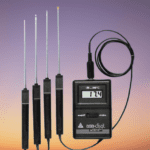
What is the temperature measurement range of the sensor?
Answer: The temperature measurement range varies depending on the type and model of the temperature sensor. It can range from as low as -270°C to as high as +3000°C, depending on the sensor’s specifications.
What is the accuracy of the temperature sensor?
Answer: The accuracy of a temperature sensor refers to how closely it measures the actual temperature. It is usually expressed as a percentage of the measured value or as a temperature difference in degrees Celsius or Fahrenheit.
What is the response time of the temperature sensor?
Answer: The response time is the time it takes for the temperature sensor to detect and provide an accurate reading in response to a temperature change. It is an important factor, especially in applications that require fast and real-time temperature monitoring.
Is the temperature sensor calibrated? If so, how often should it be calibrated?
Answer: Calibration ensures the accuracy and reliability of temperature sensors. The calibration interval depends on the specific sensor, its usage, and the industry standards. It is typically recommended to calibrate temperature sensors annually or as per the manufacturer’s guidelines.
What is the sensor’s resolution?
Answer: The resolution of a temperature sensor refers to its ability to detect and display small temperature changes. It is usually specified in terms of the smallest temperature difference that the sensor can detect and report accurately.
What is the power supply requirement for the temperature sensor?
Answer: Temperature sensors may require a specific power supply voltage or current to operate. It is important to ensure that the sensor is provided with the correct power supply to ensure accurate and reliable temperature measurements.
What is the physical size and form factor of the temperature sensor?
Answer: The physical size and form factor of the temperature sensor are crucial considerations, especially in space-constrained applications. Temperature sensors come in various shapes and sizes, ranging from small integrated circuits to larger probe-style sensors.
Is the temperature sensor suitable for the desired environment (e.g., high humidity, corrosive atmosphere)?
Answer: Some temperature sensors may be designed to withstand harsh environments, including high humidity, corrosive gases, or extreme temperatures. It is essential to choose a temperature sensor that is suitable for the specific environmental conditions of the application.
Does the temperature sensor require any special installation or mounting considerations?
Answer: Depending on the type of temperature sensor, it may require specific installation or mounting considerations. Some sensors may need to be securely attached to the measurement point or connected to a suitable interface or data acquisition system.

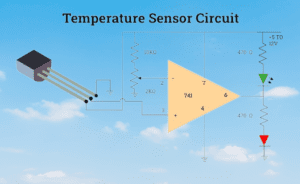
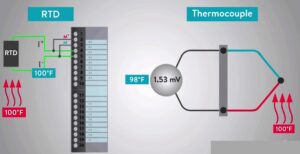
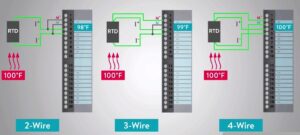 materials. They exhibit a significant change in resistance with temperature. There are two types: Negative Temperature Coefficient (NTC) thermistors, where resistance decreases with temperature, and Positive Temperature Coefficient (PTC) thermistors, where resistance increases with temperature. Thermistors are commonly used in consumer electronics, automotive applications, and temperature control systems.
materials. They exhibit a significant change in resistance with temperature. There are two types: Negative Temperature Coefficient (NTC) thermistors, where resistance decreases with temperature, and Positive Temperature Coefficient (PTC) thermistors, where resistance increases with temperature. Thermistors are commonly used in consumer electronics, automotive applications, and temperature control systems.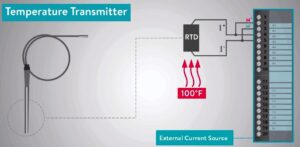 integrated circuits (ICs), to measure temperature. They utilize the temperature-dependent characteristics of semiconductors, such as voltage or current, to determine the temperature. Semiconductor sensors are compact, low-cost, and commonly used in various applications, including consumer electronics and automotive systems.
integrated circuits (ICs), to measure temperature. They utilize the temperature-dependent characteristics of semiconductors, such as voltage or current, to determine the temperature. Semiconductor sensors are compact, low-cost, and commonly used in various applications, including consumer electronics and automotive systems.